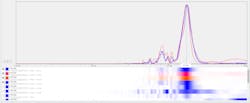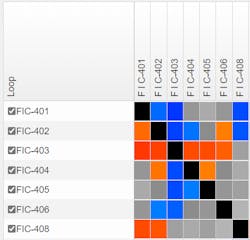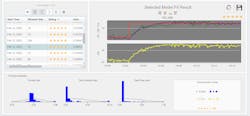Evolving technologies often seem to include ever-increasing complexity, as is seen with many types of consumer goods ranging from appliances to automobiles. While snowballing complications can be true in many cases, it is equally true that advancements can make even complex technology easier to access and use for a wider audience. As a prime example, consider the power of any mobile device, amplified when connected to cloud services, and making endless information and expansive computing experiences available for users of all skill levels.
Technology advances have also played a role within process industries for many decades, as digital control systems enabled better, safer and more efficient operation of all conceivable operations. Most of these process systems relied on some number of PID loops to control analog production actions involving flow, level, pressure, temperature and other similar properties. Applying these systems required skilled designers and engineers, but the results enabled operators to control their plants better than ever before.
Because operators greatly outnumber engineers at most plants and facilities, it makes great sense to equip operators with engineering-grade tech they can use, effectively creating an army of active participants in the campaign against inefficiency. For example, while some PID loops can be manually tuned by technicians, there are plenty of vexing cases where control loop performance monitoring (CLPM) software is capable of processing large quantities of process data and returning recommendations for optimal tuning parameters. As with mobile devices, CLPM software is another example of packaging very difficult mathematics and data gathering technology into a user-friendly format.
The newest versions of CLPM software can take things a step further by incorporating additional advanced analytical tools and process tuning forensics in ways they can be used by typical plant operations and maintenance personnel. This article describes a few of the ways plant personnel can use the most modern CLPM software to sleuth out operational problems — some of them otherwise undetectable — and then apply solutions that focus on root causes, and not on symptoms.
Identify, correlate and tune
Most end users of any type — whether a typical plant operator, maintenance tech or even an engineer — would rarely have a background in complex mathematics or data science. For these personnel to productively address process troubleshooting and optimization, they need a range of easily used CLPM functions to add to their virtual tool bag, and a reliable workflow proven to provide results. Among a variety of forensic functions, three powerful analytic tools are power spectrum, cross correlation and automatic PID modeling.
Power spectrum
Power spectrum analysis is a method for identifying bad actor loops (Figure 1). It does not determine what the root problem is, but only where there are problems. Users attempting to do this manually might stack multiple trends — on a display or using paper — and try to visually find matches indicating poor performance.
A better way is to apply CLPM software to automatically break down signals of interest into base frequencies using fast Fourier transforms (FFT). FFT is a mathematical technique for frequency/spectral analysis, and it creates a “fingerprint” of the movement or variability of a source signal, built up out of component frequencies. Once power spectrum analysis has been performed on all loops in a plant, users will see overlaps showing relations among signals. While this analysis does not determine the root cause of an issue, it identifies where issues may be shared among different process loops so users can proceed to the next step of analysis.
Cross correlation
Cross correlation is another mathematical technique that uses statistics to determine a measure of similarity between two signals, as well as the phase shift between them — meaning which signal moved first, and which followed (Figure 2). Identifying leading and lagging relationships is important for tracing the root cause of a problem. Because this method is statistics-based, it is not always perfect, and any data scientist is well aware that “correlation does not imply causation.”
Notwithstanding this, cross correlation remains an important measurement for providing visibility to potential sources of trouble. For example, if there are 100 loops in a facility, users can first use power spectrum analysis to find which loops are related, and next apply cross correlation to narrow the search and pinpoint the root cause of issues.
Automatic PID modeling
Many users simply apply CLPM software to individual loops one at a time, and they run a basic modelng routine to determine optimal tuning parameters for their needs. Indeed, this low-hanging fruit yields impressive results when harvested. But there is a more “meta” way of approaching loop reviews called automatic PID modeling (Figure 3).
CLPM software capable of automatic PID modeling constantly monitors loops for any output or setpoint changes, bracketing those events, calculating the model fits and cataloging the associated results. This activity allows the software to generate a more comprehensive understanding of the process’ dynamic behavior over time, and to provide controller tuning statistics and details based on the models. The result provides users with a broader profile of how a loop should perform under multiple ongoing scenarios, instead of calculating parameters based on its behavior from one single point in time and left to run that way forever.
Pursue an optimization workflow
One semiconductor manufacturing plant used modern CLPM software forensics to tackle an ongoing problem at their site (Figure 4). Various plant personnel noticed that a heat exchanger and an ultrapure water filter both experienced cycling over a period of time. However, these logically unrelated systems had no obvious connection, and certainly users never associated the two, but technicians were unable to satisfactorily tune either individual loop.
Eventually the team used the CLPM software forensics workflow as part of a greater plant investigation. Power spectrum analysis revealed that the two loops were indeed related, and cross correlation pointed them to the source of the issue. In this case, improved tuning was not needed. Instead, the team found that a mechanical plumbing connection was incorrectly installed between the two systems, causing the problematic interaction. Once this was corrected, the loops were tuned traditionally for optimal performance, and the automatic PID modelling function was used moving forward for continuous improvement.
A range of utility
Even the most basic process control loop troubleshooting efforts can make an impact by delivering significant production, safety and efficiency improvements. Many technical personnel have leveraged previous generations of loop tuning software to address notable problems with individual loops.
Process manufacturers will find that the latest generation of CLPM software does much more than this, empowering a much wider range of personnel to address plant optimization for individual loops, and also multiple loops with complex interactions. Not only can users of all types find solutions for apparent problems, but they can also discover and resolve previously unobserved issues.
Modern CLPM software effectively captures knowledge by spanning diverse disciplines, including mathematics, processing, digital control and many others. It then combines all these capabilities into a flexible tool, available at the fingertips of the operators. With the right software at hand, users can take advantage of a repeatable method for looking past operational symptoms to focus on and resolve the root causes of loop tuning challenges.
Robert Rice, PhD, is the vice president of engineering at Control Station. He is Control Station’s thought leader, and he has published extensively on topics associated with automatic process control, including multi-variable process control and model predictive control. Dr. Rice has been the recipient of numerous awards for innovation, and for his contributions to the advancement of the process industry.
Control Station
About the Author

Robert Rice
Vice president of engineering at Control Station
Robert Rice, PhD is the vice president of engineering at Control Station. He is Control Station’s thought leader, and he has published extensively on topics associated with automatic process control, including multi-variable process control and model predictive control. Dr. Rice has been the recipient of numerous awards for innovation, and for his contributions to the advancement of the process industry. He received his BS in Chemical Engineering from Virginia Polytechnic Institute and State University, and his MS and PhD from the University of Connecticut.



